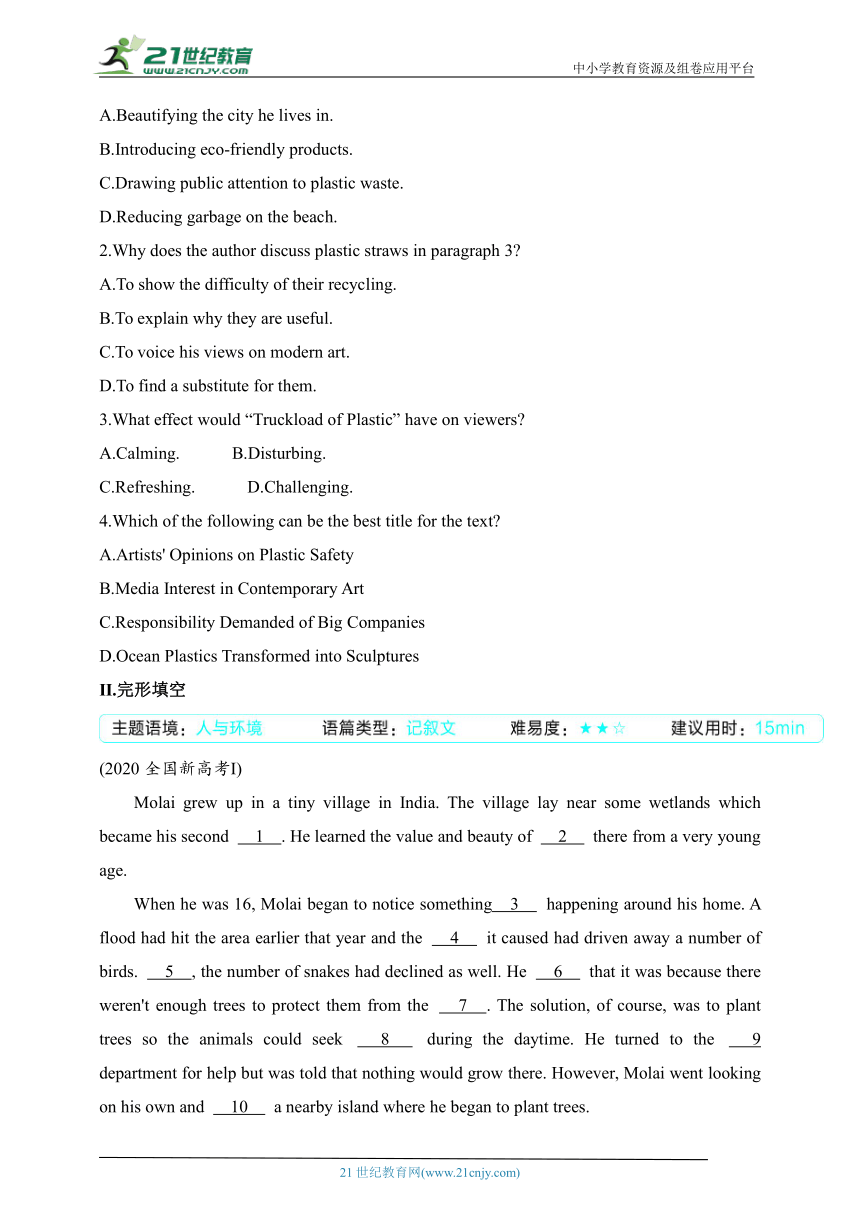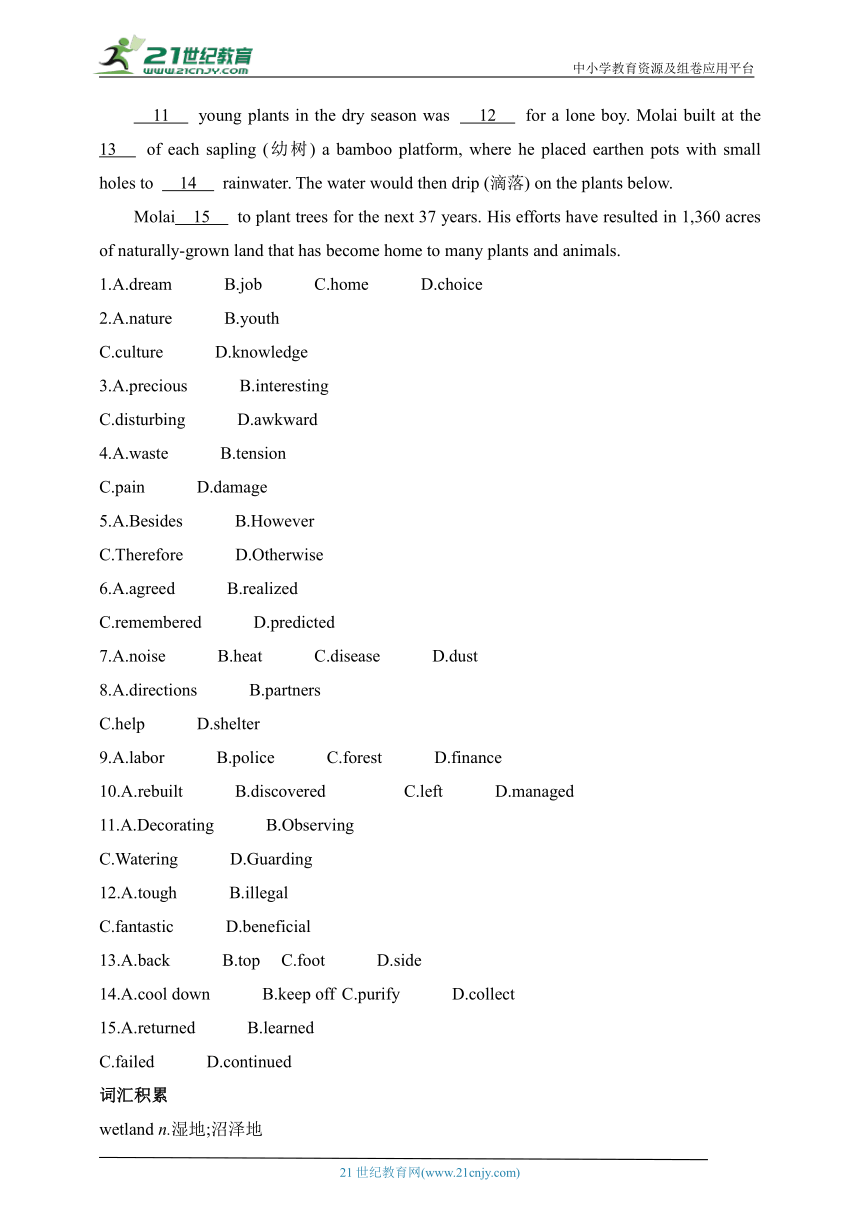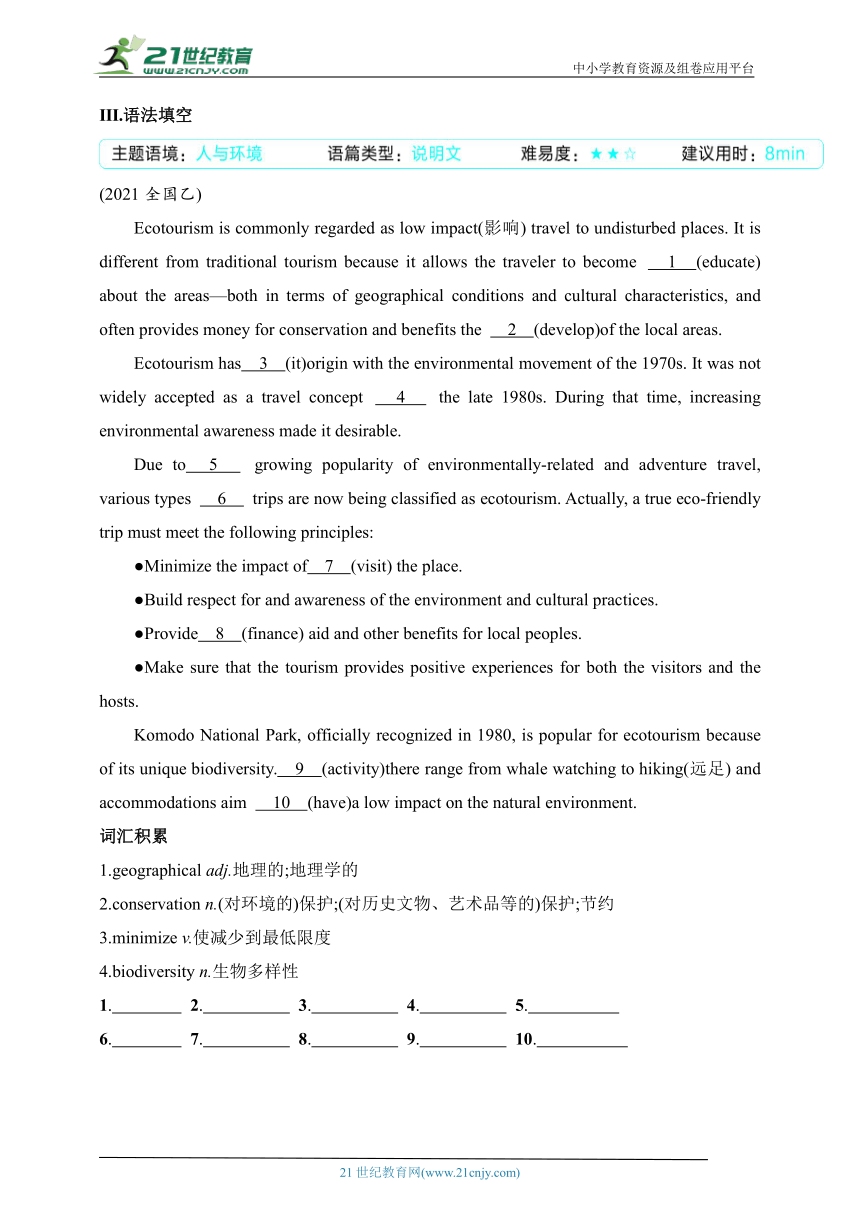2024人教版高中英语选择性必修第三册同步练习题--UNIT 3 高考练(答案与解析)
文档属性
| 名称 | 2024人教版高中英语选择性必修第三册同步练习题--UNIT 3 高考练(答案与解析) |  | |
| 格式 | docx | ||
| 文件大小 | 1.0MB | ||
| 资源类型 | 试卷 | ||
| 版本资源 | 人教版(2019) | ||
| 科目 | 英语 | ||
| 更新时间 | 2023-10-18 10:07:34 | ||
图片预览




文档简介
中小学教育资源及组卷应用平台
2024人教版高中英语选择性必修第三册同步
五年高考练
Ⅰ.阅读理解
(2021全国乙,C)
You've heard that plastic is polluting the oceans—between 4.8 and 12.7 million tonnes enter ocean ecosystems every year. But does one plastic straw or cup really make a difference Artist Benjamin Von Wong wants you to know that it does. He builds massive sculptures out of plastic garbage, forcing viewers to re-examine their relationship to single-use plastic products.
At the beginning of the year, the artist built a piece called “Strawpocalypse,”a pair of 10-foot-tall plastic waves, frozen mid-crash. Made of 168,000 plastic straws collected from several volunteer beach cleanups, the sculpture made its first appearance at the Estella Place shopping center in Ho Chi Minh City, Vietnam.
Just 9% of global plastic waste is recycled. Plastic straws are by no means the biggest source(来源) of plastic pollution, but they've recently come under fire because most people don't need them to drink with and, because of their small size and weight, they cannot be recycled. Every straw that's part of Von Wong's artwork likely came from a drink that someone used for only a few minutes. Once the drink is gone, the straw will take centuries to disappear.
In a piece from 2018, Von Wong wanted to illustrate(说明) a specific statistic:Every 60 seconds, a truckload's worth of plastic enters the ocean. For this work, titled “Truckload of Plastic,” Von Wong and a group of volunteers collected more than 10,000 pieces of plastic, which were then tied together to look like they'd been dumped(倾倒)from a truck all at once.
Von Wong hopes that his work will also help pressure big companies to reduce their plastic footprint.
词汇积累
1.make one's first appearance首次亮相
2.come under fire受到严厉批评
3.a truckload's worth of一卡车的量
4.pressure v.对……施加压力,强迫
1.What are Von Wong's artworks intended for
A.Beautifying the city he lives in.
B.Introducing eco-friendly products.
C.Drawing public attention to plastic waste.
D.Reducing garbage on the beach.
2.Why does the author discuss plastic straws in paragraph 3
A.To show the difficulty of their recycling.
B.To explain why they are useful.
C.To voice his views on modern art.
D.To find a substitute for them.
3.What effect would “Truckload of Plastic” have on viewers
A.Calming. B.Disturbing.
C.Refreshing. D.Challenging.
4.Which of the following can be the best title for the text
A.Artists' Opinions on Plastic Safety
B.Media Interest in Contemporary Art
C.Responsibility Demanded of Big Companies
D.Ocean Plastics Transformed into Sculptures
Ⅱ.完形填空
(2020全国新高考Ⅰ)
Molai grew up in a tiny village in India. The village lay near some wetlands which became his second 1 . He learned the value and beauty of 2 there from a very young age.
When he was 16, Molai began to notice something 3 happening around his home. A flood had hit the area earlier that year and the 4 it caused had driven away a number of birds. 5 , the number of snakes had declined as well. He 6 that it was because there weren't enough trees to protect them from the 7 . The solution, of course, was to plant trees so the animals could seek 8 during the daytime. He turned to the 9 department for help but was told that nothing would grow there. However, Molai went looking on his own and 10 a nearby island where he began to plant trees.
11 young plants in the dry season was 12 for a lone boy. Molai built at the 13 of each sapling (幼树) a bamboo platform, where he placed earthen pots with small holes to 14 rainwater. The water would then drip (滴落) on the plants below.
Molai 15 to plant trees for the next 37 years. His efforts have resulted in 1,360 acres of naturally-grown land that has become home to many plants and animals.
1.A.dream B.job C.home D.choice
2.A.nature B.youth
C.culture D.knowledge
3.A.precious B.interesting
C.disturbing D.awkward
4.A.waste B.tension
C.pain D.damage
5.A.Besides B.However
C.Therefore D.Otherwise
6.A.agreed B.realized
C.remembered D.predicted
7.A.noise B.heat C.disease D.dust
8.A.directions B.partners
C.help D.shelter
9.A.labor B.police C.forest D.finance
10.A.rebuilt B.discovered C.left D.managed
11.A.Decorating B.Observing
C.Watering D.Guarding
12.A.tough B.illegal
C.fantastic D.beneficial
13.A.back B.top C.foot D.side
14.A.cool down B.keep off C.purify D.collect
15.A.returned B.learned
C.failed D.continued
词汇积累
wetland n.湿地;沼泽地
Ⅲ.语法填空
(2021全国乙)
Ecotourism is commonly regarded as low impact(影响) travel to undisturbed places. It is different from traditional tourism because it allows the traveler to become 1 (educate) about the areas—both in terms of geographical conditions and cultural characteristics, and often provides money for conservation and benefits the 2 (develop)of the local areas.
Ecotourism has 3 (it)origin with the environmental movement of the 1970s. It was not widely accepted as a travel concept 4 the late 1980s. During that time, increasing environmental awareness made it desirable.
Due to 5 growing popularity of environmentally-related and adventure travel, various types 6 trips are now being classified as ecotourism. Actually, a true eco-friendly trip must meet the following principles:
●Minimize the impact of 7 (visit) the place.
●Build respect for and awareness of the environment and cultural practices.
●Provide 8 (finance) aid and other benefits for local peoples.
●Make sure that the tourism provides positive experiences for both the visitors and the hosts.
Komodo National Park, officially recognized in 1980, is popular for ecotourism because of its unique biodiversity. 9 (activity)there range from whale watching to hiking(远足) and accommodations aim 10 (have)a low impact on the natural environment.
词汇积累
1.geographical adj.地理的;地理学的
2.conservation n.(对环境的)保护;(对历史文物、艺术品等的)保护;节约
3.minimize v.使减少到最低限度
4.biodiversity n.生物多样性
1. 2. 3. 4. 5.
6. 7. 8. 9. 10.
答案与分层梯度式解析
UNIT 3 ENVIRONMENTAL PROTECTION
五年高考练
Ⅰ.◎语篇解读 本文是一篇说明文。Benjamin Von Wong用回收的废旧吸管创作艺术作品,目的是提醒人们警惕所生产、消费的塑料垃圾,以此来唤醒和提高人们的环保意识。
1.C 推理判断题。根据第一段最后两句可知,Von Wong把塑料废品制作成巨型雕塑,使观看者重新审视他们与一次性塑料制品之间的关系,由此引发公众对塑料垃圾的关注。故选C。
2.A 推理判断题。第三段第一句点明全球塑料垃圾的可回收利用率很低。第三段第二句和最后一句也分别提到“they cannot be recycled”和“the straw will take centuries to disappear”,都说明塑料吸管很难回收利用。故选A。
3.B 推理判断题。根据 Truckload of Plastic定位到第四段第二句。 Von Wong和一群志愿者把一万多件塑料制品绑在一起,看起来像是从卡车上同时倾倒出一样,冲击感强烈;根据第四段第一句可知他们想说明每60秒就有一卡车的塑料被倒入海洋,这种景象显然会令人感到不安。故选B。
4.D 主旨大意题。本文开篇介绍了艺术家 Von Wong把塑料废品制作成引人深思的雕塑,从而引发公众对海洋塑料垃圾的关注,下文介绍了他的作品及付出的努力。因此,“海洋塑料变身成雕塑”是最佳标题。故选D。
长难句
原句 Plastic straws are by no means the biggest source of plastic pollution, but they've recently come under fire because most people don't need them to drink with and, because of their small size and weight, they cannot be recycled.
分析 本句是一个并列复合句。连词but和第一个and连接并列分句;句中的because引导原因状语从句。
译文 塑料吸管绝不是塑料污染的最大来源,但是最近它们受到了严厉批评,因为大多数人不需要它们来喝东西,而且由于尺寸小、重量轻,它们不能被回收利用。
Ⅱ.◎语篇解读 本文为记叙文。一场水灾使一片有着鸟语花香的湿地变得荒芜,莫莱用了37年的时间植树造林,使这里重新成为动植物的家园。本文旨在培养学生的环保意识。
1.C 考查名词。莫莱在印度的一个小村庄长大,这个村庄坐落在一些湿地附近,那里成为他的第二个家园(home)。 A:梦,梦想;B:工作;D:选择。
2.A 考查名词。句意:他很小就认识到了那里大自然(nature)的价值和美丽。B:青年,青春;C:文化;D:知识。
3.C 考查形容词。句意:当他16岁的时候,莫莱开始注意到他家的周围发生了一些令人不安的(disturbing)事情。由下文可知,洪水破坏了此地的自然环境,使动物在湿地上无法生存,所以令人不安。A:宝贵的;B:有趣的;D:令人尴尬的,笨拙的。
4.D 考查名词。句意:那年早些时候,一场洪水袭击了该地区,造成的破坏(damage)使许多鸟类被迫离开。A:废物;B:紧张;C:痛苦。
5.A 考查副词。句意:此外(Besides),蛇的数量也下降了。B:然而;C:所以;D:否则。
6.B 考查动词。句意:他意识到(realized)这是因为没有足够的树木来保护它们免受高温。A:同意;C:记得,记住;D:预料。
7.B 考查名词。句意:他意识到这是因为没有足够的树木来保护它们免受高温(heat)。由上文可知水灾破坏了湿地的植被,毁坏了湿地的自然环境,使动物在白天因为太热无处藏身。A:噪音;C:疾病;D:灰尘。
8.D 考查名词。句意:当然,解决办法是种树,以便这些动物可以在白天寻求庇护(shelter)。A:方向;B:伙伴,搭档;C:帮助。
9.C 考查名词。句意:他向森林(forest)部门寻求帮助,但被告知那里什么都不会生长。A:劳动;B:警察;D:金融。
10.B 考查动词。句意:然而,莫莱独自去看了看,发现(discovered)了附近的一个岛屿,在那里他开始种树。 A:重建;C:离开,剩下;D:经营,管理。
11.C 考查非谓语动词。句意:在旱季浇灌(Watering)幼小的植物对男孩一个人来说是艰难的。A:装饰,点缀;B:观察,遵守;D:保卫,守卫。
12.A 考查形容词。句意:在旱季浇灌幼小的植物对男孩一个人来说是艰难的(tough)。B:违法的;C:极好的,怪诞的;D:有益的。
13.B 考查名词。句意:莫莱在每棵幼树的顶部(top)建造了一个竹子平台,在那里他放置了带有小孔的陶罐来收集雨水。A:背面,后面;C:底部;D:侧面。
14.D 考查动词及动词短语。句意:莫莱在每棵幼树的顶部建造了一个竹子平台,在那里他放置了带有小孔的陶罐来收集(collect)雨水。A:变凉;B:使……不接近;C:使纯净,净化。
15.D 考查动词。句意:莫莱在接下来的37年里继续(continued)植树,他的努力已经使得1,360英亩自然生长的土地成为许多植物和动物的家园。A:回来;B:学习;C:衰退,失败。
长难句
原句 Molai built at the top of each sapling a bamboo platform, where he placed earthen pots with small holes to collect rainwater.
分析 这是一个主从复合句。where引导定语从句,修饰先行词platform,where在定语从句中作地点状语;介词短语with small holes 作定语,修饰名词pots;不定式to collect rainwater作目的状语。
译文 莫莱在每棵幼树的顶部建造了一个竹子平台,在那里他放置了带有小孔的陶罐来收集雨水。
Ⅲ.◎语篇解读 本文为说明文。文章讲述了生态旅游的情况。
1.educated 考查过去分词。关注句式结构和设空处的句法功能。句意:它与传统旅游不同,因为它使旅行者能够在地理条件和文化特征两方面了解这些地区,并经常为(它们的)保护提供资金,有利于当地的发展。设空处与the traveler为逻辑上的被动关系,因此使用过去分词形式(educated)作表语。
易错归因 本题易误填成education或educator。education或educator虽然也是由educate转换而来,却不符合该句子描述的情境。
2.development 考查名词。关注设空处前的定冠词及设空处的句法功能。句意见上一题。设空处前面是定冠词the,后面是介词of,且该短语作动词benefits的宾语,因此需填develop的名词形式(development)。
3.its 考查代词。设空处作后面名词的定语。句意:生态旅游起源于20世纪70年代的环境运动。设空处修饰名词,要用形容词性物主代词,因此使用it的形容词性物主代词形式(its)。
4.until 考查介词。关注句子结构和句子描述的情境。句意:直到20世纪80年代末,作为一种旅游理念,它才被广泛接受。“not...until...”为固定结构,意为“直到……才……”。因此填until。
5.the 考查冠词。关注设空处后面的名词表示泛指还是特指。句意:由于与环境相关的旅行和冒险旅行越来越受欢迎,现在各种类型的旅行正被归类为生态旅游。设空处表示特指,因此使用定冠词the。
6.of 考查介词。注意设空处前后名词的关系。此处用of表所属关系,various types of为固定结构,意为“各种类型的……”。
7.visiting 考查动名词。关注设空处的句法功能。句意:最大限度地减少参观这个地方带来的影响。设空处作介词of的宾语,因此使用visit的动名词形式(visiting)。
8.financial 考查形容词。句意:为当地人提供财政援助和其他好处。设空处修饰名词aid,需用形容词,因此使用finance的形容词形式(financial)。
9.Activities 考查名词复数。关注后面谓语动词的形式。句意:那里包含从观赏鲸鱼到远足的活动,膳宿力求对自然环境产生很低的影响。谓语动词range用的是复数形式,所以主语activity需用复数形式,因此使用activities,位于句首,首字母要大写。
10.to have 考查动词不定式。注意某些动词后用不定式作宾语。句意见上一题。aim to do sth.力求做某事,因此使用不定式形式(to have)。
长难句
原句 It is different from traditional tourism because it allows the traveler to become educated about the areas—both in terms of geographical conditions and cultural characteristics, and often provides money for conservation and benefits the development of the local areas.
分析 这是一个主从复合句。句子主干为:It is different from traditional tourism。 because 引导原因状语从句;原因状语从句中,it作主语,最后两个and连接动词allows、provides和benefits作并列谓语。
译文 它与传统旅游不同,因为它使旅行者能够从地理条件和文化特征两方面了解这些地区,并经常为(它们的)保护提供资金,有利于当地的发展。
21世纪教育网 www.21cnjy.com 精品试卷·第 2 页 (共 2 页)
21世纪教育网(www.21cnjy.com)
2024人教版高中英语选择性必修第三册同步
五年高考练
Ⅰ.阅读理解
(2021全国乙,C)
You've heard that plastic is polluting the oceans—between 4.8 and 12.7 million tonnes enter ocean ecosystems every year. But does one plastic straw or cup really make a difference Artist Benjamin Von Wong wants you to know that it does. He builds massive sculptures out of plastic garbage, forcing viewers to re-examine their relationship to single-use plastic products.
At the beginning of the year, the artist built a piece called “Strawpocalypse,”a pair of 10-foot-tall plastic waves, frozen mid-crash. Made of 168,000 plastic straws collected from several volunteer beach cleanups, the sculpture made its first appearance at the Estella Place shopping center in Ho Chi Minh City, Vietnam.
Just 9% of global plastic waste is recycled. Plastic straws are by no means the biggest source(来源) of plastic pollution, but they've recently come under fire because most people don't need them to drink with and, because of their small size and weight, they cannot be recycled. Every straw that's part of Von Wong's artwork likely came from a drink that someone used for only a few minutes. Once the drink is gone, the straw will take centuries to disappear.
In a piece from 2018, Von Wong wanted to illustrate(说明) a specific statistic:Every 60 seconds, a truckload's worth of plastic enters the ocean. For this work, titled “Truckload of Plastic,” Von Wong and a group of volunteers collected more than 10,000 pieces of plastic, which were then tied together to look like they'd been dumped(倾倒)from a truck all at once.
Von Wong hopes that his work will also help pressure big companies to reduce their plastic footprint.
词汇积累
1.make one's first appearance首次亮相
2.come under fire受到严厉批评
3.a truckload's worth of一卡车的量
4.pressure v.对……施加压力,强迫
1.What are Von Wong's artworks intended for
A.Beautifying the city he lives in.
B.Introducing eco-friendly products.
C.Drawing public attention to plastic waste.
D.Reducing garbage on the beach.
2.Why does the author discuss plastic straws in paragraph 3
A.To show the difficulty of their recycling.
B.To explain why they are useful.
C.To voice his views on modern art.
D.To find a substitute for them.
3.What effect would “Truckload of Plastic” have on viewers
A.Calming. B.Disturbing.
C.Refreshing. D.Challenging.
4.Which of the following can be the best title for the text
A.Artists' Opinions on Plastic Safety
B.Media Interest in Contemporary Art
C.Responsibility Demanded of Big Companies
D.Ocean Plastics Transformed into Sculptures
Ⅱ.完形填空
(2020全国新高考Ⅰ)
Molai grew up in a tiny village in India. The village lay near some wetlands which became his second 1 . He learned the value and beauty of 2 there from a very young age.
When he was 16, Molai began to notice something 3 happening around his home. A flood had hit the area earlier that year and the 4 it caused had driven away a number of birds. 5 , the number of snakes had declined as well. He 6 that it was because there weren't enough trees to protect them from the 7 . The solution, of course, was to plant trees so the animals could seek 8 during the daytime. He turned to the 9 department for help but was told that nothing would grow there. However, Molai went looking on his own and 10 a nearby island where he began to plant trees.
11 young plants in the dry season was 12 for a lone boy. Molai built at the 13 of each sapling (幼树) a bamboo platform, where he placed earthen pots with small holes to 14 rainwater. The water would then drip (滴落) on the plants below.
Molai 15 to plant trees for the next 37 years. His efforts have resulted in 1,360 acres of naturally-grown land that has become home to many plants and animals.
1.A.dream B.job C.home D.choice
2.A.nature B.youth
C.culture D.knowledge
3.A.precious B.interesting
C.disturbing D.awkward
4.A.waste B.tension
C.pain D.damage
5.A.Besides B.However
C.Therefore D.Otherwise
6.A.agreed B.realized
C.remembered D.predicted
7.A.noise B.heat C.disease D.dust
8.A.directions B.partners
C.help D.shelter
9.A.labor B.police C.forest D.finance
10.A.rebuilt B.discovered C.left D.managed
11.A.Decorating B.Observing
C.Watering D.Guarding
12.A.tough B.illegal
C.fantastic D.beneficial
13.A.back B.top C.foot D.side
14.A.cool down B.keep off C.purify D.collect
15.A.returned B.learned
C.failed D.continued
词汇积累
wetland n.湿地;沼泽地
Ⅲ.语法填空
(2021全国乙)
Ecotourism is commonly regarded as low impact(影响) travel to undisturbed places. It is different from traditional tourism because it allows the traveler to become 1 (educate) about the areas—both in terms of geographical conditions and cultural characteristics, and often provides money for conservation and benefits the 2 (develop)of the local areas.
Ecotourism has 3 (it)origin with the environmental movement of the 1970s. It was not widely accepted as a travel concept 4 the late 1980s. During that time, increasing environmental awareness made it desirable.
Due to 5 growing popularity of environmentally-related and adventure travel, various types 6 trips are now being classified as ecotourism. Actually, a true eco-friendly trip must meet the following principles:
●Minimize the impact of 7 (visit) the place.
●Build respect for and awareness of the environment and cultural practices.
●Provide 8 (finance) aid and other benefits for local peoples.
●Make sure that the tourism provides positive experiences for both the visitors and the hosts.
Komodo National Park, officially recognized in 1980, is popular for ecotourism because of its unique biodiversity. 9 (activity)there range from whale watching to hiking(远足) and accommodations aim 10 (have)a low impact on the natural environment.
词汇积累
1.geographical adj.地理的;地理学的
2.conservation n.(对环境的)保护;(对历史文物、艺术品等的)保护;节约
3.minimize v.使减少到最低限度
4.biodiversity n.生物多样性
1. 2. 3. 4. 5.
6. 7. 8. 9. 10.
答案与分层梯度式解析
UNIT 3 ENVIRONMENTAL PROTECTION
五年高考练
Ⅰ.◎语篇解读 本文是一篇说明文。Benjamin Von Wong用回收的废旧吸管创作艺术作品,目的是提醒人们警惕所生产、消费的塑料垃圾,以此来唤醒和提高人们的环保意识。
1.C 推理判断题。根据第一段最后两句可知,Von Wong把塑料废品制作成巨型雕塑,使观看者重新审视他们与一次性塑料制品之间的关系,由此引发公众对塑料垃圾的关注。故选C。
2.A 推理判断题。第三段第一句点明全球塑料垃圾的可回收利用率很低。第三段第二句和最后一句也分别提到“they cannot be recycled”和“the straw will take centuries to disappear”,都说明塑料吸管很难回收利用。故选A。
3.B 推理判断题。根据 Truckload of Plastic定位到第四段第二句。 Von Wong和一群志愿者把一万多件塑料制品绑在一起,看起来像是从卡车上同时倾倒出一样,冲击感强烈;根据第四段第一句可知他们想说明每60秒就有一卡车的塑料被倒入海洋,这种景象显然会令人感到不安。故选B。
4.D 主旨大意题。本文开篇介绍了艺术家 Von Wong把塑料废品制作成引人深思的雕塑,从而引发公众对海洋塑料垃圾的关注,下文介绍了他的作品及付出的努力。因此,“海洋塑料变身成雕塑”是最佳标题。故选D。
长难句
原句 Plastic straws are by no means the biggest source of plastic pollution, but they've recently come under fire because most people don't need them to drink with and, because of their small size and weight, they cannot be recycled.
分析 本句是一个并列复合句。连词but和第一个and连接并列分句;句中的because引导原因状语从句。
译文 塑料吸管绝不是塑料污染的最大来源,但是最近它们受到了严厉批评,因为大多数人不需要它们来喝东西,而且由于尺寸小、重量轻,它们不能被回收利用。
Ⅱ.◎语篇解读 本文为记叙文。一场水灾使一片有着鸟语花香的湿地变得荒芜,莫莱用了37年的时间植树造林,使这里重新成为动植物的家园。本文旨在培养学生的环保意识。
1.C 考查名词。莫莱在印度的一个小村庄长大,这个村庄坐落在一些湿地附近,那里成为他的第二个家园(home)。 A:梦,梦想;B:工作;D:选择。
2.A 考查名词。句意:他很小就认识到了那里大自然(nature)的价值和美丽。B:青年,青春;C:文化;D:知识。
3.C 考查形容词。句意:当他16岁的时候,莫莱开始注意到他家的周围发生了一些令人不安的(disturbing)事情。由下文可知,洪水破坏了此地的自然环境,使动物在湿地上无法生存,所以令人不安。A:宝贵的;B:有趣的;D:令人尴尬的,笨拙的。
4.D 考查名词。句意:那年早些时候,一场洪水袭击了该地区,造成的破坏(damage)使许多鸟类被迫离开。A:废物;B:紧张;C:痛苦。
5.A 考查副词。句意:此外(Besides),蛇的数量也下降了。B:然而;C:所以;D:否则。
6.B 考查动词。句意:他意识到(realized)这是因为没有足够的树木来保护它们免受高温。A:同意;C:记得,记住;D:预料。
7.B 考查名词。句意:他意识到这是因为没有足够的树木来保护它们免受高温(heat)。由上文可知水灾破坏了湿地的植被,毁坏了湿地的自然环境,使动物在白天因为太热无处藏身。A:噪音;C:疾病;D:灰尘。
8.D 考查名词。句意:当然,解决办法是种树,以便这些动物可以在白天寻求庇护(shelter)。A:方向;B:伙伴,搭档;C:帮助。
9.C 考查名词。句意:他向森林(forest)部门寻求帮助,但被告知那里什么都不会生长。A:劳动;B:警察;D:金融。
10.B 考查动词。句意:然而,莫莱独自去看了看,发现(discovered)了附近的一个岛屿,在那里他开始种树。 A:重建;C:离开,剩下;D:经营,管理。
11.C 考查非谓语动词。句意:在旱季浇灌(Watering)幼小的植物对男孩一个人来说是艰难的。A:装饰,点缀;B:观察,遵守;D:保卫,守卫。
12.A 考查形容词。句意:在旱季浇灌幼小的植物对男孩一个人来说是艰难的(tough)。B:违法的;C:极好的,怪诞的;D:有益的。
13.B 考查名词。句意:莫莱在每棵幼树的顶部(top)建造了一个竹子平台,在那里他放置了带有小孔的陶罐来收集雨水。A:背面,后面;C:底部;D:侧面。
14.D 考查动词及动词短语。句意:莫莱在每棵幼树的顶部建造了一个竹子平台,在那里他放置了带有小孔的陶罐来收集(collect)雨水。A:变凉;B:使……不接近;C:使纯净,净化。
15.D 考查动词。句意:莫莱在接下来的37年里继续(continued)植树,他的努力已经使得1,360英亩自然生长的土地成为许多植物和动物的家园。A:回来;B:学习;C:衰退,失败。
长难句
原句 Molai built at the top of each sapling a bamboo platform, where he placed earthen pots with small holes to collect rainwater.
分析 这是一个主从复合句。where引导定语从句,修饰先行词platform,where在定语从句中作地点状语;介词短语with small holes 作定语,修饰名词pots;不定式to collect rainwater作目的状语。
译文 莫莱在每棵幼树的顶部建造了一个竹子平台,在那里他放置了带有小孔的陶罐来收集雨水。
Ⅲ.◎语篇解读 本文为说明文。文章讲述了生态旅游的情况。
1.educated 考查过去分词。关注句式结构和设空处的句法功能。句意:它与传统旅游不同,因为它使旅行者能够在地理条件和文化特征两方面了解这些地区,并经常为(它们的)保护提供资金,有利于当地的发展。设空处与the traveler为逻辑上的被动关系,因此使用过去分词形式(educated)作表语。
易错归因 本题易误填成education或educator。education或educator虽然也是由educate转换而来,却不符合该句子描述的情境。
2.development 考查名词。关注设空处前的定冠词及设空处的句法功能。句意见上一题。设空处前面是定冠词the,后面是介词of,且该短语作动词benefits的宾语,因此需填develop的名词形式(development)。
3.its 考查代词。设空处作后面名词的定语。句意:生态旅游起源于20世纪70年代的环境运动。设空处修饰名词,要用形容词性物主代词,因此使用it的形容词性物主代词形式(its)。
4.until 考查介词。关注句子结构和句子描述的情境。句意:直到20世纪80年代末,作为一种旅游理念,它才被广泛接受。“not...until...”为固定结构,意为“直到……才……”。因此填until。
5.the 考查冠词。关注设空处后面的名词表示泛指还是特指。句意:由于与环境相关的旅行和冒险旅行越来越受欢迎,现在各种类型的旅行正被归类为生态旅游。设空处表示特指,因此使用定冠词the。
6.of 考查介词。注意设空处前后名词的关系。此处用of表所属关系,various types of为固定结构,意为“各种类型的……”。
7.visiting 考查动名词。关注设空处的句法功能。句意:最大限度地减少参观这个地方带来的影响。设空处作介词of的宾语,因此使用visit的动名词形式(visiting)。
8.financial 考查形容词。句意:为当地人提供财政援助和其他好处。设空处修饰名词aid,需用形容词,因此使用finance的形容词形式(financial)。
9.Activities 考查名词复数。关注后面谓语动词的形式。句意:那里包含从观赏鲸鱼到远足的活动,膳宿力求对自然环境产生很低的影响。谓语动词range用的是复数形式,所以主语activity需用复数形式,因此使用activities,位于句首,首字母要大写。
10.to have 考查动词不定式。注意某些动词后用不定式作宾语。句意见上一题。aim to do sth.力求做某事,因此使用不定式形式(to have)。
长难句
原句 It is different from traditional tourism because it allows the traveler to become educated about the areas—both in terms of geographical conditions and cultural characteristics, and often provides money for conservation and benefits the development of the local areas.
分析 这是一个主从复合句。句子主干为:It is different from traditional tourism。 because 引导原因状语从句;原因状语从句中,it作主语,最后两个and连接动词allows、provides和benefits作并列谓语。
译文 它与传统旅游不同,因为它使旅行者能够从地理条件和文化特征两方面了解这些地区,并经常为(它们的)保护提供资金,有利于当地的发展。
21世纪教育网 www.21cnjy.com 精品试卷·第 2 页 (共 2 页)
21世纪教育网(www.21cnjy.com)
